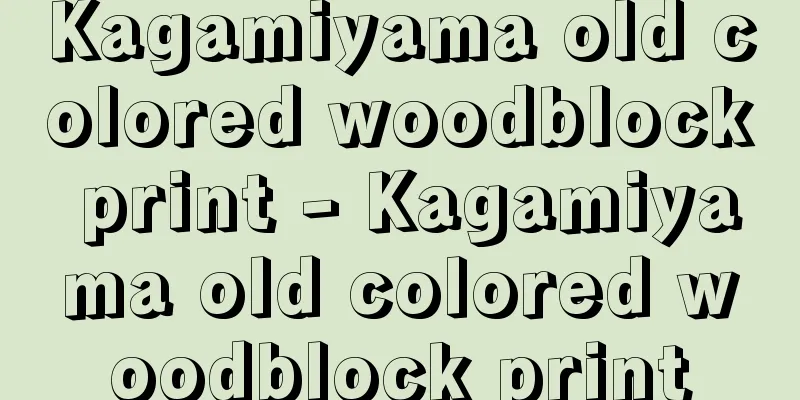Geta - Japanese wooden clogs

|
A type of footwear. A strap is attached to a wooden base (also called the "ko"). Its distinctive feature is that the base has teeth; there are those where the teeth are part of the base (renshi) and those where a separate piece of wood is inserted (sashi). There are also special types such as beach geta, which are worn on sandy ground, and suberi geta, which are worn on ice. Renshi geta include niwa geta, koma geta, Nikko geta, Satsuma geta, and uma geta, while sashi geta include atoba geta, taka geta (also called ashida), hiyori geta, and hoba geta. In the feudal era, when rural areas were forced to be self-sufficient, cedar was often used for the materials used, but later, light, strong and unbreakable paulownia and mountain paulownia were widely used, and oak and magnolia were used for the teeth of the insert. The Aizu region of Fukushima Prefecture is famous for producing high-quality paulownia wood, followed by Niigata and Yamagata Prefectures. [Takeshi Endo] historyGeta from the Yayoi period include ta-geta. Ta-geta are large geta used in muddy rice fields and were used as a type of farming tool in rural areas throughout Japan, with early examples having been excavated from the Toro ruins in Shizuoka City. Also, from the Kofun period, stone imitations, called ishi-geta, have been excavated from ancient tombs in the Kinai and Kanto regions. Relics from the Nara period, such as rengashi-geta, were excavated from the ruins of Heijo Palace. From the Heian period onwards, the term "kure no ashida" can be found not only in relics but also in The Pillow Book and Utsubo Monogatari. "Kure" is an archaic word for tree, and "ashida" means under the feet, or in other words, ashida. They are also mentioned in the Konjaku Monogatari (Tales of Times Now Past and Present), Uji Shui Monogatari (Tales of Uji), and the Genpei Jōsuiki (Records of the Rise and Fall of the Genpei Period), and are also depicted in the Senmen Koshakyō (Ancient Fan-Shaped Sutra) (owned by Shitennoji Temple, Osaka), which uses illustrations based on the manners and customs of the time, as well as in the Bandainagon Ekotoba (Illustrated Words of Ban Dainagon), Shigisan Engi (The Legends of Mount Shigisan), and the Rokudō Emaki (Illustrated Scrolls of the Six Paths). All of the illustrations show geta with ginkgo teeth. There are even painted geta. During the Kamakura and Muromachi periods, documents, paintings, and artifacts related to geta gradually increased. Of particular note is the "Seventy-first Craftsmen's Poetry Contest," which shows a craftsman making geta and using a hot iron tong to make holes in the straps (called eyes). This shows that there were geta sellers at the time, just like zori (Japanese sandal) sellers. However, it was not until the Edo period that geta became widely used, with the creation of mountain geta, which were made and sold by woodcutters, willow geta (also called yanagi geta), whose shape is unclear, and uma geta. Uma geta have a rectangular base made of cedar wood, with a diamond shape carved out of the center of the sole, and because the geta leaves a horseshoe-shaped mark, they are also called horse claws, which is an early term for komageta. Komageta have been used since before the Genroku period (1688-1704), when men wore them for wetlands, while women wore them with hollowed out soles and oval shapes. Robo geta, which have a tooth handle carved into the base, were used for rainy days and can be seen in Saikaku's Ukiyo-zoshi. Paulownia geta began to be used during the Genroku period, and in the following Hoei period (1704-1711), they became popular under the name Odawara geta, as a geta maker who lived near Edo's fish market (Odawara-cho) made them from island paulownia. Also, the beginning of Edo-nuri geta, gehou geta with a base made of straight-grained paulownia and rounded oak teeth, were popular as footwear for actors. During the time of the eighth Tokugawa Shogun, Yoshimune, three-toothed geta appeared and became the footwear of courtesans, but at first the teeth were not very high. Also, geta with a back tooth, which was hollowed out in the front and had a recessed tooth in the back, was invented, and rectangular, square geta called Sukeroku geta were used in Kyogen performances by male dandy actors and were loved by a certain group of people. Vermilion-painted pokkuri komageta were popular among young women. Not only that, but the base of the geta was luxuriously made with bamboo or rattan tatami mats, and the wood of the geta was made with meticulous attention to the straight grain and flat grain of paulownia wood, and the paint was also vermilion or black, and riveted, making elaborate geta, ushering in the golden age of geta. In Edo, geta with high teeth were called ashida, and geta with low teeth were called hiyori geta, and both men and women wore them, clicking their teeth even on sunny days. This distinction in Edo did not exist in Kyoto or Osaka; they were all called geta or sashiba geta, and were round in shape for both men and women. In the Kansei era (1789-1801), two more practical types of geta appeared, Dojima and Nakaore geta. Dojima is a type of weather geta with a paulownia wood base with carved teeth, a top and riveted on top, and was worn mainly by craftsmen. Nakaore, on the other hand, is also called origeta or hikizuri, and was introduced to Edo where it was called Dojima geta. The toothless paulownia base is cut in half down the middle, and leather is riveted to the base surface and connected, with an oak insert at the back to prevent the base from wearing down. Nakaore geta was worn by people of the middle class or higher, and was also suitable for walking on marshes. In the Kasei era (1804-1830), when Edo culture was at its peak, men's geta called Hanemushi, made of paulownia and chestnut, appeared, as well as round geta with a front called Hikitsuke geta. Also, to compete with the Hanemushi-shaped Shikan geta from Nakamura Utaemon III (Baigyoku), Edo female impersonator Iwai Hanshiro V introduced Hanshiro geta, which competed for supremacy. Hanshiro geta are a type of high, hollowed-out geta that resemble a pokkuri. Courtesans in Yoshiwara used the high Hanshiro geta, which they called Yoshiwara Tayu geta. At the end of the Edo period, Iinase geta appeared in Edo. They were narrow geta with a front and a narrow "nomeri-gata" style, likely named for their slender shape. With the Meiji Restoration, Western culture was introduced, and a new trend was introduced into the world of clothing. Westernization gradually spread, and the world of footwear also began to undergo some changes. However, since the world of clothing was still centered on Japanese clothing, the world of geta continued from before, with men's geta in the Dojima, Atomaru, Ryoguri, Shinbashi-gata, Nikko-geta, Shibagon-geta, Satsuma-geta, Hiyori-geta, and ashida styles. Women's geta in the Komachi-gata, Dojima, Mannengata, Ryoguri, Atomaru, Azuma-geta, Kushi-gata, Hiyori-geta, Atosa, and ashida styles. [Takeshi Endo] Modern GetaThey are common and do not feel formal or stuffy. They match well with yukata, tsumugi and kasuri clothing as a hobby, but do not match with dressy kimonos. Women's geta are classified according to the material and finish, such as plain wood paulownia or cedar, lacquered or pasted, and according to the type of shape, such as komageta, hiyori geta, ashida, nomeri geta with a boat bottom, and pokkuri. Plain paulownia geta with straight grain are considered the best, and paulownia geta, pasted geta and lacquered geta have been used for going out since ancient times. Lacquered geta and carved geta do not show dirt and give the feet a clean look. Pokkuri geta are used during the Shichigosan celebrations for girls and by maiko in Kyoto. Men's geta come in a variety of types, including those made of paulownia wood, hari-masu wood, and tatami-surfaced wood, and are fitted with black or dark brown velvet straps. Geta bases can be wide or narrow. In recent years, kimonos have changed from everyday wear to going out and formal wear, and zori (Japanese sandals) are becoming the standard footwear for wearing with Japanese clothing. Also, with the development of fully paved roads and the need to change into geta at your destination, fewer people are using geta these days. However, geta remain an indispensable part of Japanese life, whether worn in the garden, strolling around at festivals, or enjoying the cool evening air. [Yasu Fujimoto] "History of the Evolution of Footwear" by Imanishi Uzo (1950, Dosho Kankokai)" ▽ "Folk Fashion Journal: Footwear Edition" by Miyamoto Seisuke (1933, Yuzankaku) ▽ "Tokyo Customs and Manners, Volume 2" by Hiraide Kojiro (1959, Tomiyamabo) [Reference] | |©Katsuya Nishikawa "> Main types of geta A pair of sandals depicted in a picture scroll from the Heian period. The teeth are ginkgo-shaped, with the lower part of the teeth spreading out. "Ban Dainagon Ekotoba" (detail) Facsimile held by the National Diet Library "> Footwear seen in the Ban Dainagon Ekotoba Source: Shogakukan Encyclopedia Nipponica About Encyclopedia Nipponica Information | Legend |
|
履き物の一種。木製の台(甲(こう)ともいう)部に鼻緒をすげた履き物。その特色は台に歯がついていることで、歯が台といっしょのもの(連歯(れんし))と、別の材を差し込んだもの(差歯(さし))とがある。またなかには、砂地で履く浜下駄、あるいは氷上で履くすべり下駄など特殊なものもある。連歯下駄には庭下駄、駒(こま)下駄、日光下駄、薩摩(さつま)下駄、馬下駄などがあり、差歯下駄には後歯(あとば)下駄、高(たか)下駄(足駄ともいう)、日和(ひより)下駄、朴歯(ほおば)下駄などがある。 材料は、農村が自給自足を強いられていた封建時代には、杉材で多くつくられたが、のち軽くてしかもじょうぶで割れない桐(きり)、山桐などが多く用いられ、差歯の歯は、樫(かし)、朴(ほお)などが用いられた。産地では、福島県会津地方が、上質の桐材を出すところから名高く、新潟、山形県がこれに次いでいる。 [遠藤 武] 歴史下駄は、弥生(やよい)時代のものとしては田下駄がある。田下駄は泥田地帯で用いる大きなもので、日本では全国的に農村で農具の一種として使用されたが、その初期のものが、静岡市の登呂(とろ)遺跡から出土している。また古墳時代に入ると、石製模造品である石下駄が、畿内(きない)や関東の古墳から出土している。奈良時代の遺物としては、平城宮跡から連歯下駄が出土している。平安時代に入ると、遺物ばかりでなく、『枕草子(まくらのそうし)』や『うつほ物語』に「くれのあしだ」の語がみえる。「くれ」は木の古語であり、「あしだ」は足下(あした)、つまり足駄のことである。また『今昔物語』『宇治拾遺物語』をはじめ、『源平盛衰記』にも記されているが、また当時の風俗を下絵とした『扇面古写経』(大阪・四天王寺蔵)をはじめ、『伴大納言絵詞(ばんだいなごんえことば)』『信貴山(しぎさん)縁起』、六道絵巻のなかにも描かれている。図はいずれも足駄であり、歯は銀杏(いちょう)歯である。なかには塗り下駄さえみられる。 鎌倉・室町時代となると、下駄に関する文献、絵画、遺物もしだいに多くなり、とくに注意すべきは『七十一番職人歌合(しちじゅういちばんしょくにんうたあわせ)』のなかに、足駄つくりの姿がみられ、台に焼火箸(やけひばし)で鼻緒の穴(これを眼(め)という)をあけている。当時は草履(ぞうり)売りと同様に、足駄売りのあったことを示すものである。 しかし、下駄が広く一般化していくのは、江戸時代に入ってからで、木こりがつくって売り出した山下駄、形は明らかではないが柳を材とした柳下駄、あるいは馬下駄がつくられた。馬下駄は、長方形の杉材を台とし、その下裏中央を菱(ひし)形にくりぬいたもので、下駄の跡が馬蹄(ばてい)形となるところから馬の爪(つめ)ともいわれ、駒下駄の初期的な言い方である。 駒下駄は、元禄(げんろく)(1688~1704)以前から用いられ、男は湿地用にこれを履き、女は下裏を刳(くり)形にして形は楕円(だえん)であった。また歯の柄(ほぞ)を台にくりぬいて出した露卯(ろぼう)の下駄は、雨天用として用いられ、西鶴(さいかく)の浮世草子のなかにみられる。桐下駄が用いられるのは元禄からで、次の宝永(ほうえい)年間(1704~1711)になると、江戸の魚河岸(うおがし)近く(小田原町)に住んでいた下駄師が島桐でつくったところから、小田原下駄の名で、流行した。また江戸塗り下駄の始まりで、柾目(まさめ)の桐を台とし、樫の歯を丸歯とした外法(げほう)下駄が、役者の履き物として人気があった。 徳川8代将軍吉宗(よしむね)の時世となると、三枚歯の下駄が現れて遊女の履き物となったが、最初は歯はあまり高いものではなかった。また後(あと)歯という、前はくりぬき、後ろを差歯としたものが考案され、助六下駄といわれる長方形の角形(かくがた)物が、男伊達(だて)の狂言に用いられ、一部の人たちに愛用された。朱塗りのぽっくり駒下駄が、若い女性たちの間に人気があった。そればかりではなく、台に竹や籐(とう)の畳付きのぜいたくなものがつけられ、下駄の材も桐の柾目、板目に細心の心配りがされ、塗りにも朱塗り、黒塗り、これに鋲(びょう)打ちなど、手の込んだものがつくられ、下駄の黄金時代に入っていった。江戸では下駄の歯の高いものを足駄といい、歯の低いものを日和下駄といって、天気のよい日でも歯を鳴らして、男女ともに用いた。江戸でのこの区別は、京都や大坂にはなく、みな下駄または差歯下駄とよび、形は男女ともに丸形であった。 寛政(かんせい)年代(1789~1801)に入ると、差歯下駄にかわって、実用的な堂島(どうじま)と中折(なかおれ)下駄の2種が現れた。堂島は日和下駄の一種で、台は桐のくりぬき歯で、表をつけた上から鋲打ちにしたもので、職人たちがおもに履いた。一方、中折は、折下駄とも「ひきずり」ともいわれ、江戸に伝わり、堂島下駄とよばれた。歯のない桐の台を中央から二つ切りとし、台の面に革を鋲打ちにしてつないだもので、後方部に樫入れをして台の減るのを防いだ。中折は中流以上の人が履くもので、湿地を歩くにも適した。 江戸文化が爛熟(らんじゅく)した化政(かせい)年代(1804~1830)に入ると、羽根虫という桐、栗(くり)を使った男物が現れ、また引付(ひきつけ)下駄といわれる丸形表付きのものができた。また3世中村歌右衛門(うたえもん)(梅玉)から出た羽根虫形の芝翫(しかん)下駄に対抗して、江戸女形の5世岩井半四郎より半四郎下駄が登場し、覇を競った。半四郎下駄は、ぽっくりに似た、高い刳(くり)下駄の一種である。吉原(よしわら)の遊女たちは、半四郎下駄の高いのを用い、これを吉原太夫(たゆう)下駄とよんだ。幕末になると、江戸でいなせ下駄が出た。表付きの幅の狭い「のめり形」のもので、その形がすらっとしているところからの名前であろう。 明治維新となり、欧米文化がもたらされ、服装界にも新風が導入され、洋風化がしだいに普及し、履き物界にもやや変動が起こり始めた。しかしまだ、服装界は和服中心の時代であったから、下駄の世界は、前からの延長で、男物では堂島、後(あと)丸、両刳(ぐり)、新橋形、日光下駄、芝翫下駄、薩摩下駄、日和下駄、足駄が使用されていた。女物では小町形、堂島、万年形、両刳、後丸、吾妻(あづま)下駄、櫛(くし)形、日和下駄、後歯、足駄などが使用されていた。 [遠藤 武] 現代の下駄正式な堅苦しさを感じさせない庶民的なものである。浴衣(ゆかた)に、また紬(つむぎ)や絣(かすり)の装いに趣味のものとして調和し、ドレッシーな着物には調和しない。女物の下駄には、桐や杉の白木、塗り、張りなど、素材や仕上げによる区別と、駒下駄、日和下駄、足駄、舟底型ののめり下駄、ぽっくりなど、形の種類による区別がある。柾目の通った白木の桐の下駄を最高とし、桐下駄や張り柾の下駄、塗り下駄は、昔から外出用として用いられてきた。塗り下駄や彫りの下駄などは、汚れが目だたず足元が引き締まってみえる。ぽっくりは、女児の七五三の祝いのときや、京の舞妓(まいこ)などが用いる。 男物の下駄には、桐柾、張り柾、畳表を張ったものなどがあり、これに黒、焦げ茶などのビロードの鼻緒をつける。下駄の台は、幅広のものと細身のものとがある。近年は、着物が普段着から外出着、盛装用へと変わり、和服の履き物といえば草履(ぞうり)が一般的になりつつある。また、道路舗装の完備、下駄は出向いた先で履きかえなければならないことなどもあり、最近では下駄を用いる人が少なくなってきている。しかし、庭履きに、縁日のそぞろ歩きや夕涼みに、下駄は日本の暮らしに欠くことができないものである。 [藤本やす] 『今西卯蔵著『はきもの変遷史』(1950・同書刊行会)』▽『宮本勢助著『民間服飾誌履物編』(1933・雄山閣)』▽『平出鏗二郎著『東京風俗志 中巻』(1959・冨山房)』 [参照項目] | |©西川勝也"> 下駄のおもな種類 平安時代の絵巻に描かれた足駄。歯の下側が広がる銀杏歯であることがわかる。『伴大納言絵詞』(部分) 模写国立国会図書館所蔵"> 『伴大納言絵詞』にみる足駄 出典 小学館 日本大百科全書(ニッポニカ)日本大百科全書(ニッポニカ)について 情報 | 凡例 |
Recommend
Hirooka Kyuemon - Hirooka Kyuemon
This was the nickname of the successive heads of t...
Kingdom of Buganda - Buganda Kingdom (English spelling) Buganda
A powerful kingdom that flourished in East Africa ...
Vulcan gun
An aircraft machine gun that fires by rotating si...
Stone sickle - Ishigama
A type of ground stone tool. It is a stone tool m...
Credit; creditor; Cr.
A term unique to double-entry bookkeeping. In doub...
Pelargonium
A general term for the genus Pelargonium (Japanes...
Objective litigation - Objective litigation
In addition, under the current administrative lit...
Lathyrus japonicus (English spelling)
… [Hiroyoshi Ohashi]. … *Some of the terminology ...
Agam, Y. (English spelling) AgamY
...From the late 1950s, a major movement in kinet...
True Taoism - Shindai Dokyo
A sect of new Taoism. In 1142 (the second year of...
Iberian pole stave - Iberian pole stave
…This shape is not found in Eastern Europe, but i...
Cisalpina
…But the founding of the library (moved from Ferr...
Kano-oba - Her aunt
…Gaganbo means “mother mosquito.” Originally it w...
Minami Shiga Ruins
Located in Minamishiga-cho, Otsu City, Shiga Prefe...
Water poppy
A perennial aquatic plant of the family Psammaceae...









